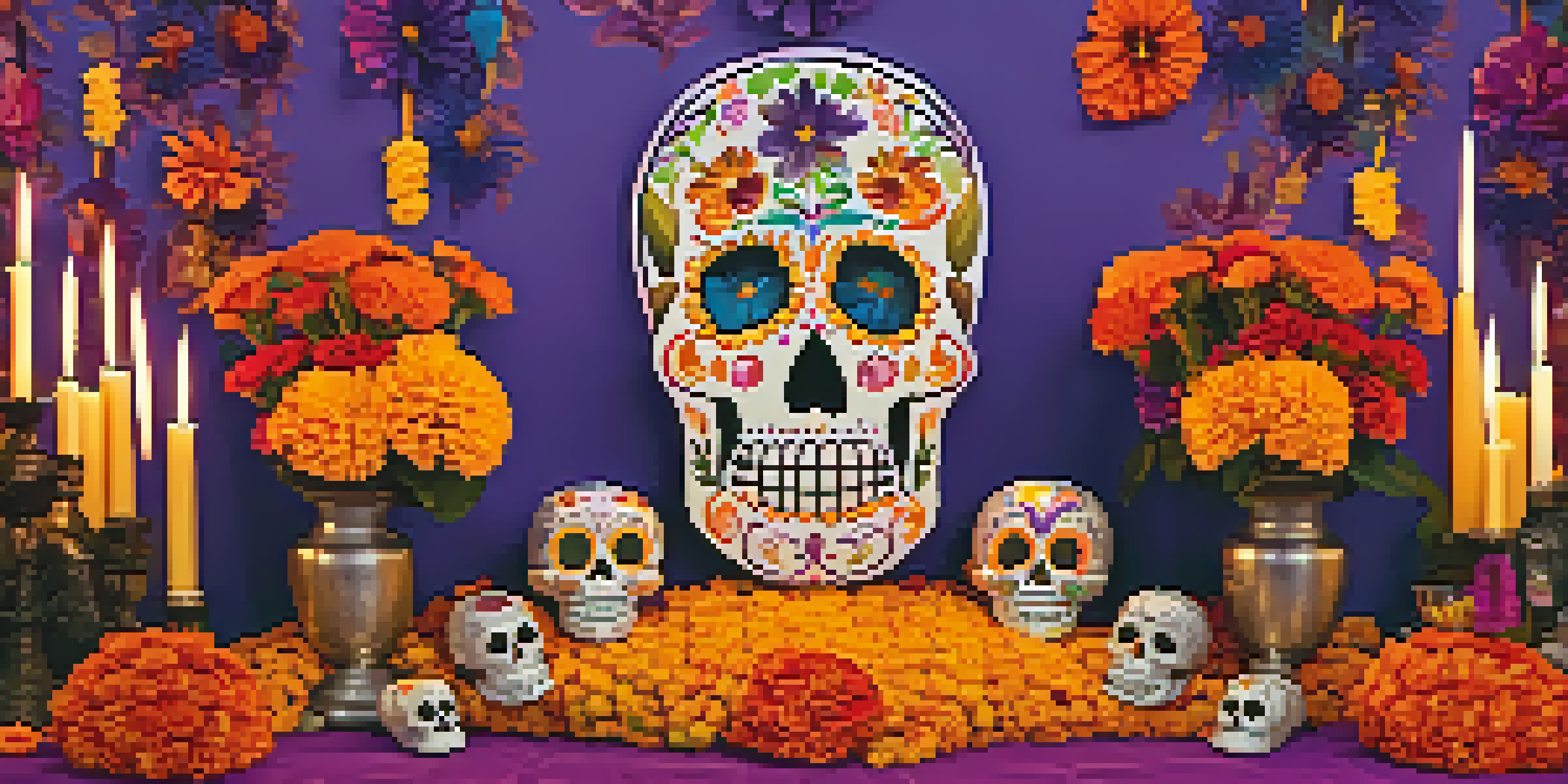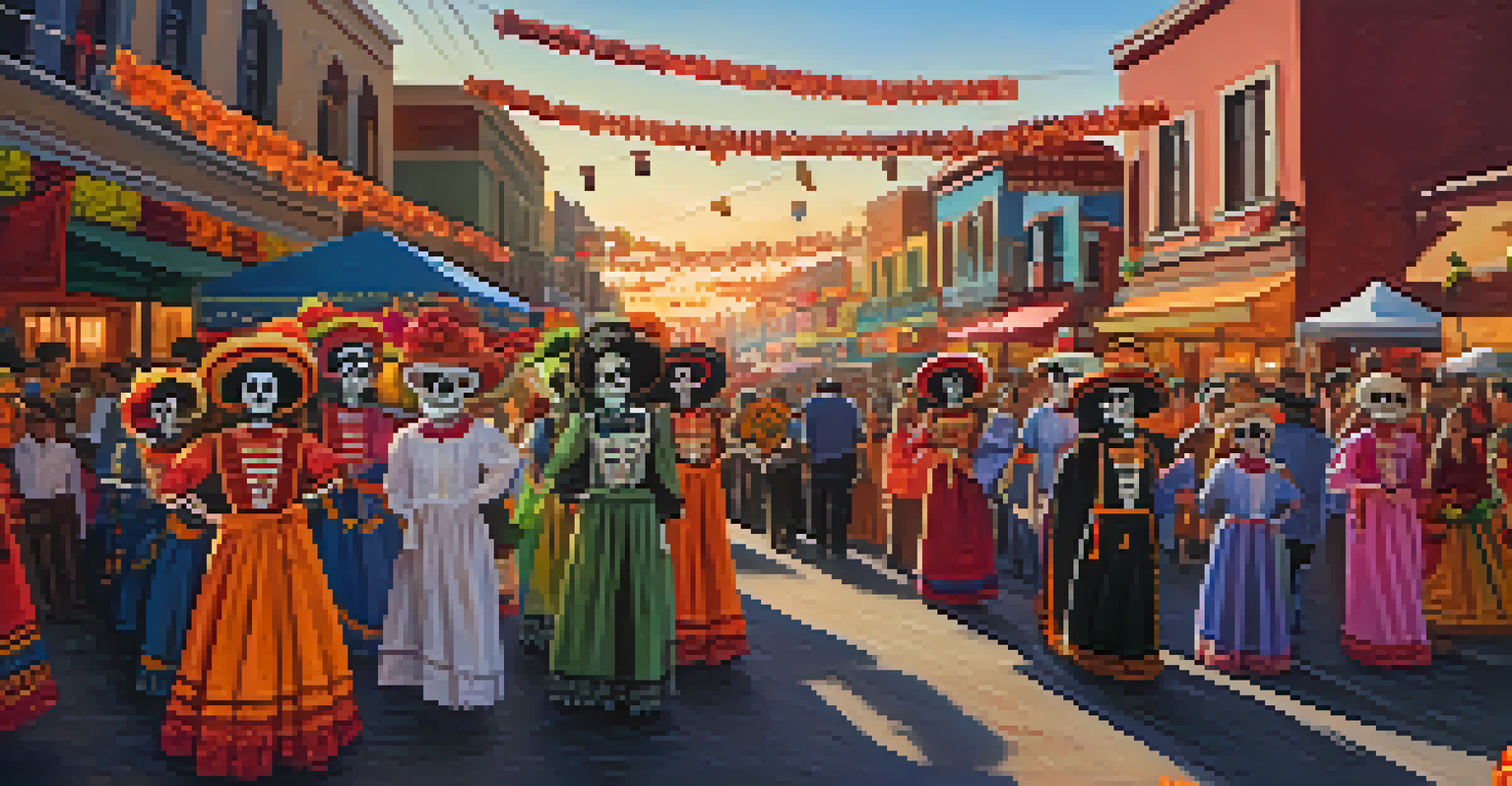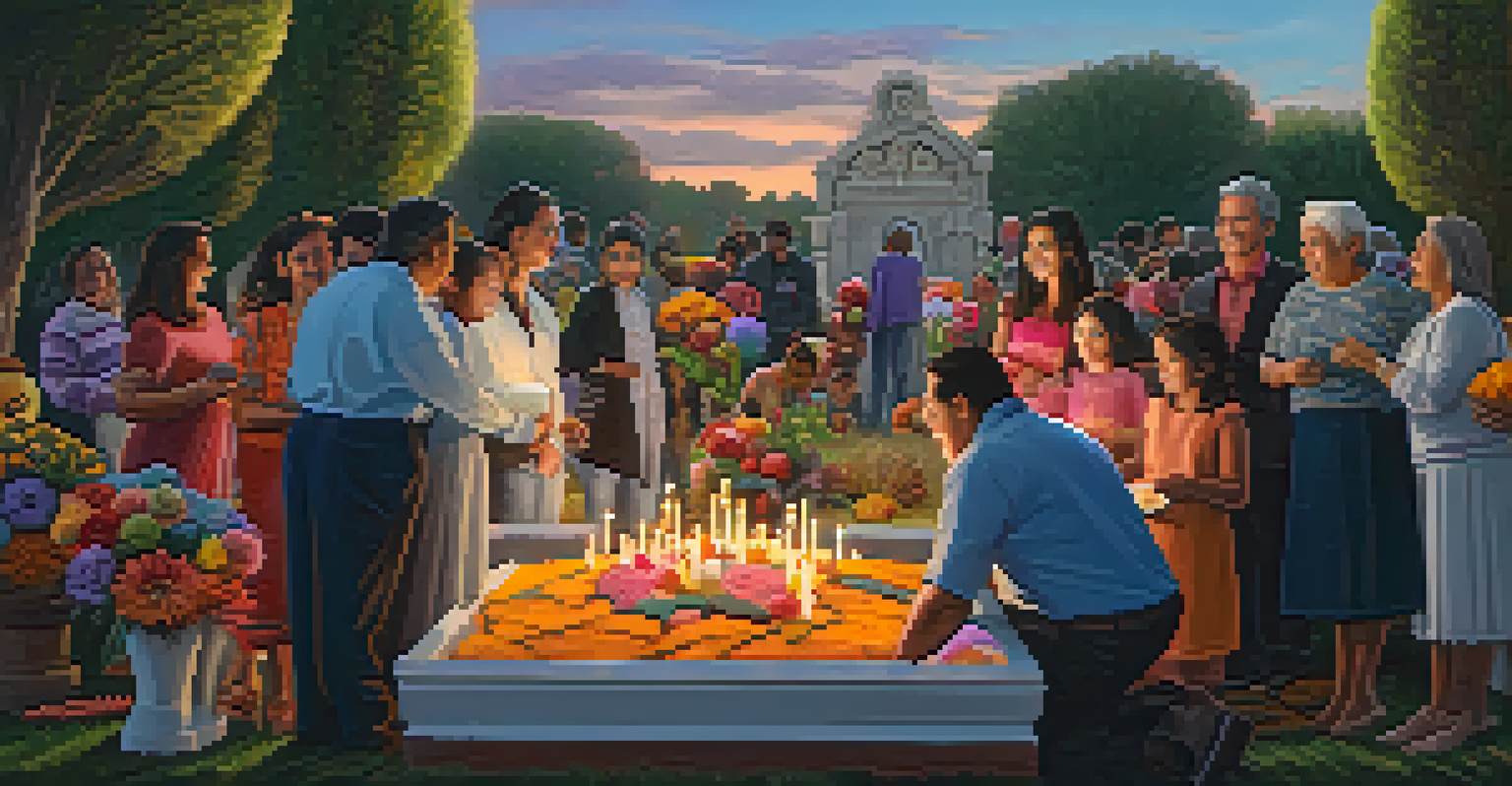The Global Significance of the Day of the Dead in Mexico

Understanding the Day of the Dead: More Than Just a Celebration
The Day of the Dead, or Día de los Muertos, is a vibrant Mexican tradition that honors deceased loved ones. Celebrated on November 1st and 2nd, it blends indigenous rituals with Spanish Catholic influences. This unique holiday showcases colorful altars, or ofrendas, adorned with photos, food, and items cherished by the departed.
To live in hearts we leave behind is not to die.
At its core, Día de los Muertos serves as a reminder to celebrate life and death. Instead of mourning, families gather to share stories and remember the joyful moments spent with those who have passed away. This perspective transforms grief into a celebration, fostering a deeper connection between the living and the dead.
The customs associated with the Day of the Dead vary across regions, showcasing Mexico's rich cultural diversity. From the grand parades of Mexico City to intimate family gatherings in rural villages, each celebration reflects the community's unique heritage and values.
The Cultural Symbolism Behind Día de los Muertos
Every element of Día de los Muertos carries significant meaning. For instance, marigolds, known as cempasúchil, are used to guide spirits back to the living world with their bright color and scent. Sugar skulls, or calaveras, symbolize the sweetness of life, reminding us to embrace joy amidst sorrow.

The skull, often seen in decorations, is a playful representation of death in Mexican culture. It signifies that death is not something to fear, but rather a part of the natural cycle of life. This humorous take on mortality encourages a more accepting attitude toward death, fostering resilience and hope.
Día de los Muertos Celebrates Life
This vibrant tradition transforms grief into a celebration, allowing families to honor and remember their loved ones with joy.
Moreover, the traditional foods prepared for the occasion, such as pan de muerto (a sweet bread), hold familial significance. Each recipe is often passed down through generations, creating a delicious link between past and present, and reinforcing the importance of family and heritage.
Global Recognition: How the Day of the Dead Went Worldwide
In 2008, UNESCO recognized the Day of the Dead as an Intangible Cultural Heritage of Humanity, amplifying its significance beyond Mexico. This acknowledgment helped raise awareness about the holiday's rich customs and traditions, inviting people from various cultures to participate and learn. As a result, Día de los Muertos has gained popularity in many countries.
Death is nature's way of telling you to slow down.
Cities like Los Angeles, San Antonio, and New York host large-scale celebrations, featuring altars, parades, and cultural exhibitions. These events not only honor Mexican heritage but also create spaces for multicultural exchange, where people can share their own traditions related to death and remembrance.
As the holidays evolve, they reflect a blend of cultural influences, creating a unique tapestry that celebrates both Mexican roots and global diversity. This fusion not only enriches local cultures but also fosters understanding and appreciation among diverse communities.
Art and Expression: The Creative Impact of Día de los Muertos
Día de los Muertos has inspired countless artists, musicians, and writers, leading to a flourishing of creative expressions. From intricate papel picado (perforated paper) to stunning face paintings, the holiday's visual elements are a feast for the eyes. Artists use these mediums to convey deep emotions related to life and death, making the holiday a rich source of inspiration.
Moreover, contemporary interpretations of Día de los Muertos continue to emerge. Musicians blend traditional sounds with modern genres, while filmmakers explore themes of loss and remembrance through storytelling. This artistic evolution keeps the holiday fresh and relevant for new generations, ensuring its continued significance.
Cultural Symbolism is Key
Every aspect of Día de los Muertos, from marigolds to sugar skulls, carries deep meaning, reflecting a unique Mexican perspective on life and death.
Artistic expressions during Día de los Muertos not only preserve cultural traditions but also spark conversations about mortality and memory. By showcasing these themes in relatable ways, artists invite audiences to reflect on their own experiences with loss, fostering a shared understanding of the human condition.
Community and Family: The Heart of Día de los Muertos
At its essence, Día de los Muertos is a communal celebration that brings families and friends together. The act of creating ofrendas encourages collaboration and bonding, as each member contributes items that were meaningful to the departed. This collective effort strengthens familial ties and fosters a sense of belonging.
Families often visit cemeteries to clean and decorate the graves of their loved ones, transforming these spaces into vibrant celebrations of life. These gatherings provide an opportunity to share stories, laughter, and tears, reinforcing the idea that the deceased remain a part of the family even after they are gone.
The holiday also serves as a reminder of the importance of community support during times of grief. Neighbors often come together to share food, stories, and memories, creating a network of love and understanding that helps everyone navigate their feelings about loss.
Educational Opportunities: Learning Through Día de los Muertos
Día de los Muertos presents a unique opportunity for educational institutions to teach students about cultural diversity and historical perspectives on death. Schools often incorporate activities such as crafting sugar skulls or creating altars, encouraging students to engage with the holiday's traditions. This hands-on approach fosters appreciation for different cultures and their practices.
Furthermore, by discussing the significance of the holiday, educators can challenge misconceptions about death and mortality. Students learn that different cultures have varied ways of understanding and coping with loss, promoting empathy and respect for diverse beliefs and practices.
Global Growth, Local Integrity
As Día de los Muertos gains international recognition, communities strive to preserve its authenticity and educate newcomers about its significance.
As more schools celebrate Día de los Muertos, they contribute to a broader understanding of cultural heritage. These educational initiatives not only enrich students' knowledge but also cultivate a sense of global citizenship, preparing them for a more interconnected world.
The Future of Día de los Muertos: Preserving Tradition Amid Change
As Día de los Muertos gains global popularity, there's a growing concern about preserving its authenticity amidst commercialization. While it's wonderful to see more people embracing the holiday, it's crucial to honor its roots and ensure that the traditions are passed down with respect and understanding. Communities are actively working to educate newcomers about the significance of each custom to maintain the holiday's integrity.
Moreover, the influence of social media has transformed how the holiday is celebrated and shared. While this has led to increased visibility, it also raises questions about cultural appropriation and the commodification of sacred traditions. Striking a balance between celebration and respect is essential to keep the spirit of Día de los Muertos alive.

Ultimately, the future of Día de los Muertos lies in the hands of those who cherish and celebrate it. By promoting awareness and understanding, communities can ensure that this beautiful tradition continues to thrive, enriching lives for generations to come.